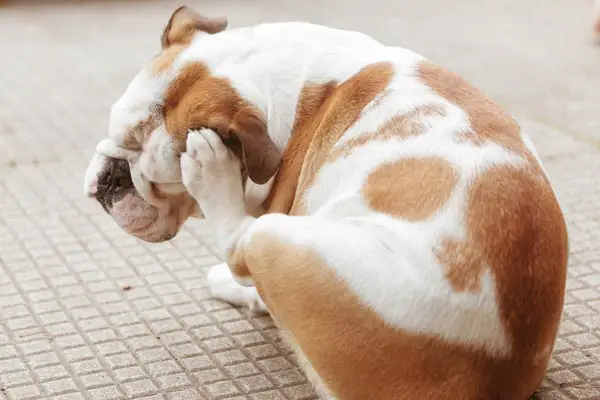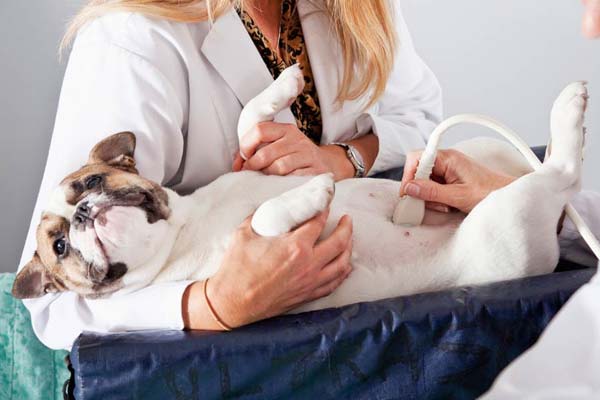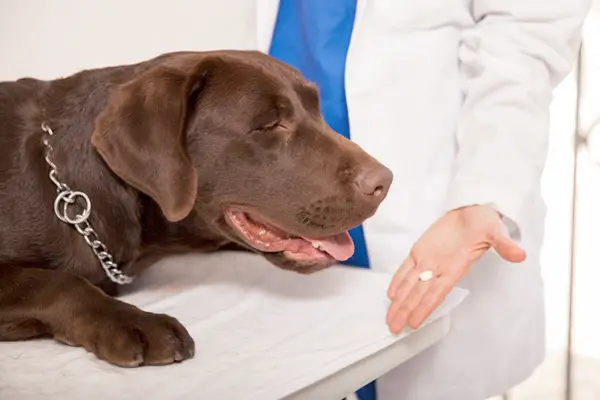Home Front: Battling Fleas With Natural Remedies
“If you go long enough without a bath, even the fleas will leave you alone,” quipped Ernie Pyle.
Fortunately, there are more effective ways to battle fleas that plague pets than the humorous solution suggested by the famous World War II correspondent.
In fact, 21st-century man has compiled a large arsenal of natural remedies to combat flea infestation.
What are the Signs of Fleas?
The first step to solving a dog’s flea problem is to identify it early. This enables the owner to begin treating the pet before the infestation threatens its health.
The following symptoms may indicate a dog has a flea problem:
Abnormal Behavior – One sign of a flea problem is unusual behavior by a pet. If the dog is scratching, licking, shaking itself, rubbing against objects repeatedly, it may be a sign that fleas are present in its coat.
Irritated Skin – When a dog has a serious flea infestation, the repeated itching and licking of the affected areas can create irritated areas of skin that appear red and inflamed. These “hot spots” are another visible sign of fleas.
Visible Signs of Fleas – A pet owner can also detect fleas through a simple examination of the dog’s fur and skin.
The Banfield Pet Hospital walks owners through the steps of a flea exam in its helpful YouTube video “How to Check for Fleas on your Dog or Cat.”
What are the Home Remedies for Fleas on Puppies under 12 Weeks?
Mature dogs that suffer from fleas may be treated with powerful drugs prescribed by veterinarians.
Yet, when puppies less than 12 weeks old are infected with fleas, strong medication can be fatal.
This does not mean that the fleas should not be ignored though, because the parasites present a real danger to the young dog.
A flea infestation can seriously threaten a puppy’s health. Since they are smaller in size, a puppy can be susceptible to developing anemia if the fleas are too numerous.
The parasites can also cause respiratory distress and general weakness.
To treat puppies safely it is necessary for a pet owner to rely on natural flea remedies. The following is a brief description of some effective and safe treatments:
Grooming with a Flea Comb – A flea comb is a special grooming tool equipped with fine metal teeth that will trap any adult fleas, larvae or flea droppings on the puppy.
Experts recommend that you groom a puppy three times a day during a flea infestation.
Be sure to keep a bowl of soapy water nearby so that you can drown any adult fleas caught by the comb’s teeth. This grooming is one natural step in dealing with a flea problem.
Bathing with Mild Detergent – Another simple weapon in battling a puppy’s flea problem is a warm bath with gentle detergent.
Though not a medicated flea shampoo, scientists have discovered that common dish soap is effective in killing fleas.
What are the Health Complications of Fleas On Your Dog?
Though fleas are a perennial problem for dogs and their owners, this doesn’t mean flea infestation should be accepted as normal and harmless. Fleas can be a real threat to a dog’s health in several ways.
First, fleas can lead to tapeworms. “These are parasites that are passed to your pet when they actually ingest the flea,” says Dr. Adam Denish, a veterinarian at the Rhawnhurst Animal Hospital in Pennsylvania.
Fleas carry tapeworm larvae and when a pet licks itself, it may swallow the flea. This allows the larvae to grow into an adult parasite and attach to the dog’s intestinal tract.
Adult tapeworms may eventually grow from four to eight inches long.
A sign that a pet is infected with a tapeworm may be the presence of pieces of tapeworm segments in a dog’s stools.
A 2008 Turkish study led by Dr. Erol Ayaz, it was found that garlic is a very effective treatment for tapeworms.
Pet experts recommend feeding peeled and chopped garlic to an infected dog twice a day.
The dosage should be based on the size of the pet: a small dog needs ¼ a clove; a medium-sized dog requires ½ a clove, and a large dog can have ¾ a clove.
Second, fleas can cause anemia in dogs. Since fleas are parasites that feed on the blood of their host animal, a serious infestation can result in a significant blood loss for a pet.
Some signs of anemia are pale gums, lowered body temperature, and fatigue. These low blood counts are especially dangerous for young puppies and may be fatal.
What is Flea Allergy Dermatitis in Dogs?
One of the most irritating effects of a flea to a dog is canine atopic dermatitis. This is a skin disease that dogs develop due to an allergic reaction to a substance in its environment. Fleas cause dermatitis when a dog is allergic to the insect’s saliva.
The signs of the disease are inflamed areas of skin, with continual itching or licking of the affected region.
There may also be a loss of hair and be scabbing in the inflamed area. Generally, the hindquarter region is most affected.
Unfortunately, it doesn’t take a serious flea infestation to cause dermatitis. One to two flea bites in a week can cause the issue to persist.
Flea allergy dermatitis is the most common chronic skin issue for dogs. Dr. Jon D. Plant, a specialist in veterinary dermatology advises that the best treatment is aimed at reducing flea bites on allergic dogs.
He also recommends treated infected areas with anti-inflammatory substances to reduce a pet’s discomfort.
What is the Life Cycle of a Flea?
It is important to understand the life cycle of a flea in order to battle the parasites effectively.
As Amanda Frederick, a veterinary technician at the Texas A&M University College of Veterinary Medicine states, “The best way to control fleas is to break the cycle.
More fleas lay more eggs. … the best treatment either kills the adults or kills one of the juvenile stages.”
There are four stages in the life of a flea: egg, larva, pupa, and adult. The following is a brief description of each stage.
Egg – Once an adult female flea has jumped onto a dog, it will normally bite it within five minutes and begin to feed on its blood.
In the next day and a half, the flea will lay its eggs onto the skin of a dog. It can lay up to 50 eggs a day, even though this is equal to its body weight.
This is possible because the female flea feeds aggressively. In a 1991 study at Purdue University, Dr. Michael W. Dryden found that an adult female flea can consume as much as 13.6 ul of blood in a day – over 15 times her weight.
This can continue for 100 days, so the number of eggs laid by one flea can easily reach into the thousands.
Once laid, the eggs are not attached to the dog’s skin, so they will roll off onto the ground where they will hatch into a larva in two to 12 days.
Larva – A flea larva has no legs and is very small and colored white. The larva feeds on its own skin as it sheds it, and also on the feces of adult fleas.
Researchers have found that fleas can excrete large amounts of feces each day, ranging from 0.645 mg to 0.770 mg.
Since adult fleas consume more blood than they actually need, the resulting feces is rich in nutrients from the host’s blood.
Dr. Jules Silverman and Dr. Arthur Appel compared the blood of a host animal with the feces from an adult flea in 1994.
“Total fecal protein differed slightly from host blood indicating that there was little digestion of host blood by adult fleas,” they reported.
Pupa – A flea remains as a larva from four to 18 days. Once the larva reaches its full size, it spins a cocoon, which is four to five millimeters long and two millimeters thick.
Over the next three to six days, the larvae molt into a pupa. It then progresses from the pupae stage to the adult stage while still in the cocoon.
Though this may occur within a week, it may also last up to a year. The reason for the variable time range is due to the adult flea’s need for food immediately upon leaving the cocoon.
If there is no host animal nearby, the adult flea in the cocoon can remain dormant up to 155 days without eating.
When the dormant flea senses the vibrations, body heat, or exhaled carbon dioxide form of a dog near its location, it will emerge from the cocoon. This is the beginning of its adult stage in the life cycle.
Since fleas are somewhat immune to many treatments during the larvae and pupa stage, one important weapon in battling them is the vacuuming and cleaning of any surfaces where larvae and pupa may lodge.
One study by Texas A&M found that this can remove 30 percent of larvae and 60 percent of eggs.
Adult – An adult flea must find food within a week of emerging from its cocoon. If the conditions are ideal for the flea, with a humid, warm environment, they may live longer. Yet, eventually, they must find a dog to attach to and feed upon its blood.
Once the flea jumps on a host, it will bite it and begin to feed within a few minutes. As it gets adjusted to this normal diet, it quickly becomes dependent on a regular supply of food.
Dr. Dryden found that if an adult flea is removed from its host, it will then die in a few days without food.
To thrive, adult fleas need a humid, warm environment. If the relative humidity is less than 50% or the temperature is higher than 95 degrees Fahrenheit, it is difficult for fleas to survive.
This means that during the summer heat, a favorite location for fleas to wait for their next dog will be in shady areas near moisture.
What Does a Flea Egg Look Like?
A dog flea egg is approximately 0.5 millimeters in size and is oval-shaped with a white pearly color.
Once laid by an adult female flea, the eggs will not attach to the dog’s body, so they often roll off onto the ground.
For this reason, eggs may be found in pet bedding and in carpeting.
How Do I Remove Fleas from My Dog?
There are several simple steps to remove fleas from a dog. They are as follows:
Step #1-Grooming – Grooming a dog with a brush and flea comb is a good way to begin flea removal.
First, brush the dog’s fur with a normal dog brush to remove any knots, tangles, or loose hair fibers that have been shed. Follow this up with grooming the fur with a flea comb with metal teeth.
Begin at the head and neck area of the dog and work down to the tail area, since the fleas will naturally try to escape the grooming tools.
As each area is groomed, watch for fleas that are trapped in the fine teeth of the comb. Rinse the comb regularly in a dish of soapy water to remove and kill the trapped fleas.
Step #2 – Bathing – Following up the grooming with a bath in lukewarm soapy water is a good next step.
Begin working the warm solution into the dog’s fur at the head, ears, and neck until suds appear.
Work carefully so that no water enters the eyes or ears. Continue this process all the way to the dog’s tail tip and its toes.
Allow the soap suds to remain in the fur for several minutes before rinsing with clean lukewarm water.
Step # 3 – Wash Bedding – After the fleas have been removed from the dog, it is important to prevent infestation from reoccurring.
This means the dog’s environment must be free from fleas. The place to begin this is with the dog’s bedding.
First, vacuum the bedding to remove any flea eggs. Since flea eggs cling to material easily and can survive a trip through the hot-water cycle of the washing machine, it is necessary to remove as many as possible through vacuuming.
Be sure to dispose of the vacuum bag after cleaning the bedding, since flea eggs can live and hatch inside the bag.
Launder the bedding using the hot cycle. Though not completely effective in destroying the eggs, the washing will kill adult fleas and larvae. To strengthen the soap’s effectiveness, add ¼ a cup of white vinegar to the load.
Step # 4 – Clean the Environment – The final step is to clean the dog’s environment of any adult fleas, eggs, or larvae.
Flea eggs, larvae, and pupa can easily lodge in the carpets, cracks, and crevices of a home where the dog lives, so that even after the first three steps fleas can infest the pet again.
First, thoroughly vacuum the floors, paying attention to corners and crevices where eggs may hide as well as favorite areas where the dog likes to stay.
This will also remove the flea feces which is a food source for the larvae. Dispose of the vacuum bag, sealing it tightly in a trash bag.
Next, treat the carpeted floors with a natural flea powder made of diatomaceous earth and baking soda.
Combine the two ingredients in a 50/50 concentration and sprinkle on the carpet. Leave the powder on the carpet for a minimum of 24 hours, then vacuum the floor.
This process should be repeated again in seven days to remove any larvae that may hatch out after the first time.
How Soon Can You Give a Dog a Bath after Flea Treatment?
For a topically applied flea treatment to be effective, it must have time to work. Experts recommend that pet owners wait a minimum of 48 hours after treatment before bathing a dog.
What are Some Natural Flea Killers?
With the battle against fleas having lasted for hundreds of years, many natural remedies have been discovered that are natural flea killers.
The following is a brief description of a few of these:
Diatomaceous Earth – This is made from diatomite, a sedimentary rock that is formed from the fossils of diatoms, tiny, shelled microorganisms that are found all over the world in soil, waterways, and oceans.
The rock formed from these fossils is easily crushed and formed into a white powder that feels like pumice powder.
Common uses of diatomaceous earth are in water filtration systems, fine polishing, and as an abrasive. Because of its abrasive quality, the powder is a natural flea killer.
Upon contact, it damages the fleas exterior surface with scratches, which causes the insect to become dehydrated and die.
Boric Acid – Another natural flea killer is boric acid. This compound is made from boron, a substance derived from borate minerals mined for industrial uses.
It is used in the production of semiconductors, in agricultural fertilizers, in the production of cleaning products such as bleach, and as an ingredient in insecticides.
In a study conducted by the USDA Household Insects Research Unit in 1994, it was found that when fleas fed on dried blood treated with boric acid a significant number were killed.
Robert Daguillard of the U.S. Environmental Protection Agency explained out boric acid works.
“Boric acid and its sodium salts can kill insects by acting as a stomach poison or by abrading the exoskeletons of insects,” he said.
Calcium Carbonate – Calcium carbonate is produced from the minerals calcite and aragonite, commonly known as limestone.
It has a wide variety of uses. It is the main ingredient of lime, an important agricultural mineral.
It is also used in medicine as a calcium supplement and as an antacid. It is widely used in the construction industry as an important ingredient in cement.
Yet, one little-known application of calcium carbonate is as a natural flea killer. In a 1994 study by researchers at the University of California, it was discovered that the compound is toxic to fleas.
“…Media containing two percent to five percent calcium carbonate killed 85%-88% of larvae,” the study reported.
Can Salt Get Rid of Fleas?
Salt has been used as an outdoor treatment for areas with fleas since the early 1900s.
The theory behind the use of salt is that since it removes moisture from a surface, it will dry out the area and cause desiccation of the fleas which leads to the death.
For indoor applications, there has been no verifiable scientific proof that salt will rid an animal or home of fleas.
Proponents for use of salt compare it to diatomaceous earth, claiming that salt acts in the same manner as diatomaceous earth.
Yet, the two substances differ radically. The diatomaceous earth kills fleas not by absorbing water but absorbing oil.
As researcher William Quarles explains, diatomaceous earth works “….not by absorbing water, but by absorbing the oily or waxy outer cuticle layer by direct contact.
When the thin(about 1/u) waterproof layer of the epicuticle is lost, the insect loses water, then dies.”
Can I Put Baking Soda on My Dog for Fleas?
The effectiveness of baking soda as a treatment for flea infestation is widely debated.
Many websites promote its use, while other sources point out that there are no reliable scientific studies establishing its power to fight fleas.
Baking soda does seem to have some positive outcomes when used to fight insects since the U.S. Environmental Protection Agency lists it as a biopesticide.
Even with the ongoing debate, if a dog owner wants to try baking soda, there is a way it can be used safely as a topical treatment for fleas.
Since it is a mild abrasive, baking soda could irritate a dog’s skin that is suffering from flea bite dermatitis if applied directly to the body.
A safer way to use it is as a bathing ingredient. A mixture of three tablespoons of baking soda with one teaspoon of liquid dish detergent and one teaspoon of baby oil can make a good shampoo for the dog’s bath.
Can I Use Apple Cider Vinegar on My Dog?
Vinegar is another popular home remedy for dogs suffering a flea infestation. While vinegar will not directly kill fleas, it can be a preventative weapon against the insects.
Its strong smell and acidic nature can be employed as a defense against fleas in two ways.
First, apple cider vinegar can be added to the pet’s water. By placing a few drops of the solution in the pet’s drinking supply, the internal chemistry of the dog’s blood may be altered to make it less palatable to fleas.
The second use for vinegar is as a bathing ingredient. A good mixture for a dog’s bath water is two parts warm water with two parts vinegar and a half cup of liquid dish detergent. Work the vinegar-laced soapy water into the dog’s fur until it produces suds.
Continue the washing for ten minutes. Then, rinse the suds with clear, warm water.
Finally, give the dog a second rinse with a mixture of clear water and apple cider vinegar.
Do Fleas Die in a Hot Dryer?
Fleas are heat sensitive insects. The temperature must remain between 55 to 95 degrees Fahrenheit for a flea to survive.
In a 1983 study, Dr. Jules Silverman and Dr. Michael K. Rust discovered that temperatures above this range are fatal for fleas, with eggs and larvae most vulnerable.
“When the temperature surpassed 35 degrees Celsius [95 degrees F] for more than 40 hours per month, there was complete mortality of larvae and pupae,” they reported.
When fighting a flea infestation, one of the steps involves deep cleaning of all bedding and clothing where adult fleas, larvae or eggs may be located.
This is very important because the process of washing the fabric and drying it in the dryer on the highest heat setting will kill the insects.
Dr. Friederike Kramer and Dr. Norbert Mencke recommend drying flea-infested fabrics for a minimum of 10 minutes at 140 degrees Fahrenheit.
Such treatment ensures the destruction of fleas at all stages of development.
What is in Dawn Dish Soap that Kills Fleas?
Dawn dish soap is an effective flea killer. The popular liquid detergent does this in several ways.
First, it inhibits a flea’s ability to survive in water. Fleas are naturally water resistant due to its tiny size and oily exterior coating.
Maurice Mitzmain published research in 1910 that documented a flea’s ability to survive seven days in water.
Dawn dish soap contains surfactants that reduce the surface tension of water. This makes it easier for a flea to sink into the dog’s bath water when it is washed off the animal’s coat.
The surfactants also increase the soap’s ability to interact with the flea’s oily exterior, removing it and decreasing its buoyancy.
The result is that Dawn causes the flea to sink under the bath water and drown.
Soap with surfactants also acts as a natural insecticide since it destroys the flea’s cell membranes, inhibiting the insect’s ability to stay hydrated internally.
“…Surfactant properties allow them to …either suffocate or disrupt important physiological processes in mites and insects,” concluded R.S. Cowles in a study published in 2000.
How Do You Prevent Fleas on Your Dog?
“An ounce of prevention is worth a pound of cure,” observed Benjamin Franklin. That homespun wisdom certainly applies to fleas.
It is much better and easier to prevent fleas than to deal with an infestation. There are several steps that a pet owner can take to prevent fleas naturally.
Use Essential Oils
Many essential oils are effective in preventing fleas on a dog. The following is a brief description of some of these:
Cedar Oil – In a 2006 study published in the Journal of Economic Entomology, researchers disclosed that three varieties of steam distilled cedar oil ware toxic to fleas. Incense-cedar heartwood was the most effective.
Cedar oil can be used in three ways as a weapon against fleas. First, it can be used compounding cleaning fluids for the home that has suffered an infestation.
Second, it can be added to a room diffuser which helps to cleanse the home and create an uninviting environment for fleas. Finally, a few drops can be applied topically to the dog’s coat.
Lemongrass Oil – While this oil will not kill the insects, it serves as a preventive flea too with its pungent aroma.
A 2008 study by the Insect Biopesticide Research Center in India found that lemongrass is a natural repellant.
Helichrysum Oil – This oil has a double benefit. It will repel fleas and also help heal a dog’s skin irritation due to flea dermatitis.
A 2014 study by Dr. R. V. Geetha reported that the oil had natural insecticidal activity.
Treat the Dog With Natural Flea Spray
Since a flea is always waiting outside to jump on a dog, a pet owner should prepare a natural flea spray and treat the dog each time it goes outside.
An effective and safe recipe includes one lemon, two rosemary sprigs, a sprig of sage, one quart of water, one sprig of lavender.
Bring the water to a near boil and combine with the lemon sliced up and the spice sprigs. Let it seep while sealed overnight.
The next morning the cooled liquid may be strained and placed in a water sprayer.
This liquid can be used safely on the dog’s body and will stay good for one to two weeks if refrigerated.
Keep Natural Flea Powder at Hand
Finally, a natural flea powder should be compounded by the dog owner and kept nearby for regular treatment of the dog’s fur.
It should include diatomaceous earth, NEEM in the dry form, and yarrow. Combine the three ingredients and place into a shaker bottle. The powder can be used regularly to help prevent fleas.
Fleas have been a scourge to man and his dogs since ancient times. They have helped transmit devastating epidemics like bubonic plague and typhus.
They cost American pet owners billions of dollars each year in care for their pets. With all the trouble these tiny insects have caused, a few steps to prevent flea infestation naturally will provide a pet owner and his or her dog with many important benefits.

![11 Best of New York Dog Parks [Free & Paid]](https://www.whatcandogseat.net/wp-content/uploads/2020/06/Best-of-New-York-Dog-Parks.jpg)




